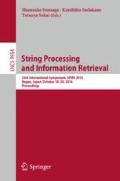Abstract
On a given sequence \(X=\langle x_1x_2\ldots x_n \rangle \), the range selection queries denoted by Q(i, j, k) return the \(k^{th}\)-smallest element on \(\langle x_ix_{i+1}\ldots x_j \rangle \). The problem has received significant attention in recent years and many solutions aiming to achieve this task with a cost lower than dynamically sorting the elements on the queried range have been proposed. The reverse problem interestingly has not yet received that much attention, although there exists practical usage scenarios especially in the time–series analysis. This study investigates the inverse range selection query \( \bar{Q}(\upsilon ,k)\) that aims to detect all possible intervals on X such that the \(k^{th}\)-smallest element is less than or equal to \(\upsilon \). We present the basic solution first and then discuss how that basic solution can be implemented with different data structures previously proposed for regular range selection queries.
Access this chapter
Tax calculation will be finalised at checkout
Purchases are for personal use only
References
Chan, T.M., Wilkinson, B.T.: Adaptive and approximate orthogonal range counting. In: Proceedings of the Twenty-Fourth Annual ACM-SIAM Symposium on Discrete Algorithms (SODA), pp. 241–251 (2013)
Gagie, T., Puglisi, S.J., Turpin, A.: Range quantile queries: another virtue of wavelet trees. In: Karlgren, J., Tarhio, J., Hyyrö, H. (eds.) SPIRE 2009. LNCS, vol. 5721, pp. 1–6. Springer, Heidelberg (2009)
Grossi, R., Gupta, A., Vitter, J.S.: High-order entropy-compressed text indexes. In: Proceedings of the 14th Annual ACM-SIAM Symposium on Discrete Algorithms, pp. 841–850. SIAM (2003)
Hoare, C.A.R.: Algorithm 65: find. Commun. ACM 4(7), 321–322 (1961)
Jørgensen, A.G., Larsen, K.G.: Range selection and median: tight cell probe lower bounds and adaptive data structures. In: Proceedings of the Twenty-Second Annual ACM-SIAM Symposium on Discrete Algorithms, pp. 805–813 (2011)
Krizanc, D., Morin, P., Smid, M.: Range mode and range median queries on lists and trees. Nord. J. Comput. 12(1), 1–17 (2005)
Külekci, M.O., Thankachan, S.V.: Range selection queries in data aware space and time. In: Data Compression Conference (DCC), pp. 73–82. IEEE (2015)
Külekci, M.O.: Enhanced variable-length codes: improved compression with efficient random access. In: Data Compression Conference (DCC), pp. 362–371. IEEE (2014)
Navarro, G.: Wavelet trees for all. In: Kärkkäinen, J., Stoye, J. (eds.) CPM 2012. LNCS, vol. 7354, pp. 2–26. Springer, Heidelberg (2012)
Okanohara, D., Sadakane, K.: Practical entropy-compressed rank/select dictionary. In: Proceedings of the Meeting on Algorithm Engineering & Expermiments, pp. 60–70. Society for Industrial and Applied Mathematics, Philadelphia (2007). http://dl.acm.org/citation.cfm?id=2791188.2791194
Petersen, H., Grabowski, S.: Range mode and range median queries in constant time and sub-quadratic space. Inform. Process. Lett. 109(4), 225–228 (2009)
Acknowledgments
The author thanks to the anonymous reviewers of the paper for their valuable corrections and comments.
Author information
Authors and Affiliations
Corresponding author
Editor information
Editors and Affiliations
Rights and permissions
Copyright information
© 2016 Springer International Publishing AG
About this paper
Cite this paper
Külekci, M.O. (2016). Inverse Range Selection Queries. In: Inenaga, S., Sadakane, K., Sakai, T. (eds) String Processing and Information Retrieval. SPIRE 2016. Lecture Notes in Computer Science(), vol 9954. Springer, Cham. https://doi.org/10.1007/978-3-319-46049-9_17
Download citation
DOI: https://doi.org/10.1007/978-3-319-46049-9_17
Published:
Publisher Name: Springer, Cham
Print ISBN: 978-3-319-46048-2
Online ISBN: 978-3-319-46049-9
eBook Packages: Computer ScienceComputer Science (R0)

